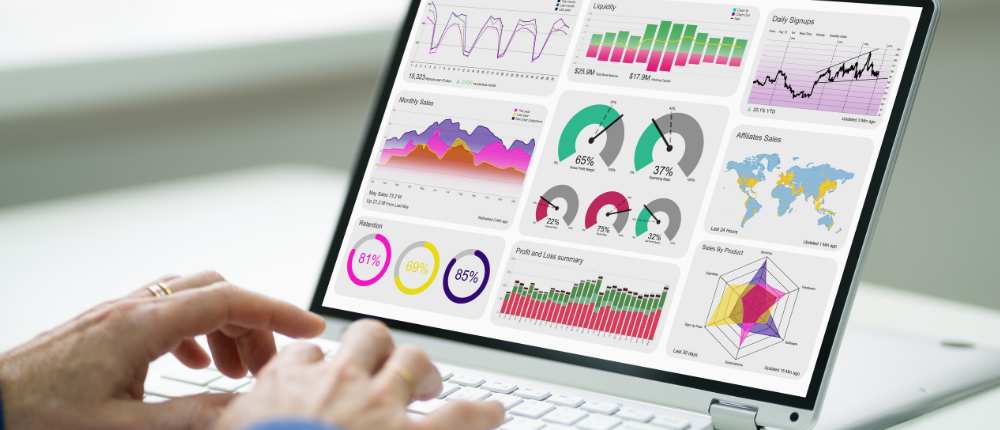Website Performance Analytics: Ultimate Guide for SMBs [2024]
The online world is huge, hosting over 1 billion websites, and 252,000 new sites pop up every single day. With that much competition, your website performance analytics become a priority. Let’s review some essential insights for SMBs and then move to a more detailed analysis of the key metrics and tools used to measure performance.
Simplifying Analytics: What SMBs Really Need
Small and medium enterprises (SMBs) often lack the resources and expertise of larger companies regarding data analytics. However, SMBs can still use data to their advantage by focusing on the essentials.
Identifying Critical Issues with Ease
In the fast-paced SMB world, you must quickly identify and address problems. Here is what is worth to be on the lookout for:
Track Website Traffic
If your overall traffic suddenly drops, something is wrong. Look at where the drop is happening – across the site or just certain pages. This could point to a technical issue or marketing problem.
Monitor Bounce Rates
Are people quickly leaving certain pages on your site? High bounce rates indicate an issue with content or user experience on those pages.
Watch Conversion Declines
A sharp drop in sales, leads, or other conversions indicates something needs your attention. Analyze the conversion funnel to find where customers are getting stuck.
Listen to Customer Complaints
More negative reviews, support tickets, or social media posts can signal an urgent problem.
Set Up Real-Time Alerts
Use analytics tools to get notifications when metrics cross concerning thresholds. Act on issues before they escalate.
Implementing Straightforward Analytics Practices
To make the most of your data analytics, try these practical tips:
- Start small. Address your top business questions first, then expand.
- Automate reporting. Set up automated data integration and reporting to save time.
- Use self-service tools. Empower your team to explore data without specialized expertise.
- Use visual insights. Use visualizations to examine data quickly and intuitively.
- Review regularly. Assess your analytics and adjust as your needs change.
By simplifying data interpretation and adopting efficient practices, SMBs can leverage data to drive strategic decisions. However, keeping tabs on crucial metrics is vital to staying ahead of your competitors in the digital space.
Key Metrics to Track
Regarding website performance analytics, there are several important metrics to focus on. Let’s go over some of the key ones:
Pageviews
Pageviews track how many times a specific page on your website is accessed and loaded in someone’s web browser. Every time a webpage is displayed, it counts as one view. So, if a visitor opens a page and refreshes or reloads it, it registers as two separate views.
To drive more views, replicate the winning traits of your top-performing pages. Make sure your website is easy to use and not cluttered. Also, remember that linking between pages is helpful.
Traffic Sources
Traffic sources indicate the different channels visitors use to access your website. While the exact sources may vary across different analytics tools, some common ones include:
- Direct: Your site is accessed directly by typing the URL into their browser or using a bookmarked link. This category can also encompass traffic with an unidentified source due to issues with cookies, source codes, etc.
- Organic Search: Visitors reached your website through unpaid search engine results, most likely from Google.
- Paid Search: This traffic comes from paid advertising links on search engine results pages to get to your site.
- Referrals: Referral traffic comes from users clicking on links to your website from other external sites.
Small business owners often struggle to get traffic. Website traffic analytics helps you see where your opportunities lie and what channels to focus on.
Device Type
Device type is the metric that tracks the various devices used to access a website over a given period.
With 45% of North American web traffic now coming from mobile devices, optimizing websites for mobile is essential. Businesses that ignore mobile optimization risk alienating a huge portion of their audience. Prioritizing a mobile-friendly design ensures a seamless experience.
Conversion Rate
Conversion rate is the percentage of website visitors who take a desired action, such as:
- Purchasing
- Subscribing to an email list
- Signing up for a free trial or demo
Tip: Seven out of 10 small business websites lack a call to action, which can impact their ability to convert website visitors into customers. This element is essential in a website’s design. It prompts users to make a purchase or sign up for a newsletter.
Location
Location is a website metric that tracks the geographical locations of your site’s visitors.
This way, you can get valuable insights into your audience’s geographic distribution, allowing you to target your marketing efforts better.
Bounce Rate
Bounce Rate tracks the percentage of visitors leaving a website after viewing only one page. A high bounce rate shows that the content is not meeting user needs, causing them to exit quickly. According to industry benchmarks, an average indicator falls between 41-55%.
Analyzing bounce rates can guide improvements to the user experience and increase engagement. For example, if you see many visitors from social media but few conversions, it’s a sign to improve the clarity of your landing pages. Likewise, if people spend little time on your site, try making your content more engaging or informative.
Session Duration
Session Duration – this metric tracks the typical amount of time users spend engaging with the website in a given visit. A “session” is defined as a series of interactions a person has with the site over a specified period, usually between one to two hours. By analyzing user session data from website performance analytics, you can gain insights into how captivating your content and online experience are.
Users typically spend around 6 seconds on a website’s main navigation menu. Thus, having a clear, easy-to-use menu to help people quickly find what they need is important.
The average time a visitor spends on a single webpage is 54 seconds. Understanding this average time on a page can guide website design and content to engage the audience better.
Interestingly, adding videos to a website can increase the average time spent on those pages by 88%. In fact, pages with video see an average of 6 minutes of user engagement.
Page Speed
Page Speed measures how quickly webpages load when someone visits a website. This is an important metric, as slow-loading pages can negatively impact the user experience. In fact, 47% of users won’t wait longer than 2 seconds for a website to load.
The homepage speed is particularly important, but the loading time of any webpage can affect the overall user experience. By regularly taking a pagespeed test, businesses can enhance customer satisfaction and better achieve their goals.
Here’s what can be done to improve your page speed:
- Only using necessary images, properly optimized for size and compression
- Hosting videos externally rather than embedding them directly
- Removing any unnecessary plugins, scripts, and CMS components
While these metrics provide tons of information, focusing on the right tools is essential.
Valuable Website Analytics Tools And Methods to Use When Tracking Your Performance
There are various ways to capture and analyze these important data points to gain valuable insights, so let’s go over them:
Google Analytics
Use Google Analytics for website performance analysis to gather data on the metrics above. The latest version, GA4, works as a website traffic checker and focuses on how visitors use your site.
What data you can get: With Google Analytics, you can track website performance metrics such as new and returning users, engagement, revenue, retention, demographics, conversions, and events. By gathering Google Analytics website performance data, you can personalize customer service.
Mixpanel
Use Mixpanel to answer all your questions through reports and easy-to-use data. You can build funnels and track user groups without needing any code.
What data you can get: With Mixpanel, you can track events, user profiles, group profiles, and lookup tables.
Gtmetrix
Use GTmentiz for a website speed test, along with graded performance reports.
What data you can get: Through Gmetrix, you can track web vitals, GTmetrix grade, performance/structure scores, HTML / total page size, and number of requests.
To gain deeper insights into user behaviour patterns, consider using these methods:
Heatmaps
Heatmaps are visual representations that use colours to show user interaction data.
Red areas indicate the most popular elements, while blue areas show the least popular.
By experimenting with the placement of buttons, links, and other page elements, heatmaps allow businesses to evaluate their website’s performance. This data can then inform decisions to improve user engagement and retention by prioritizing the most valuable user tasks and experiences.
A/B Testing
A/B testing is a systematic approach for determining what works best on a website. It involves experimenting with different variations of elements like landing pages, logos, colour schemes, user interfaces, etc.
Session Recordings
Session recordings are a useful tool for website performance analytics. They capture and replay the user’s journey across your website. These recordings allow you to observe how people move around your website. You can see what they click on or ignore while browsing. You can also identify whether they encounter any issues or obstacles along the way.
Let’s see how it might work in the real world. For example, you notice a particular page on your website has a high exit rate according to your Google Analytics data. To dig deeper, you decide to add a Hotjar heatmap to that page.
Reviewing the heatmap, you see that users largely ignore a key call-to-action button, likely contributing to the high number of people leaving the page. To confirm your hypothesis, you also review session recordings of users on that page.
The session replays show that many visitors are scrolling down the page but then rapidly exiting without converting. It seems they might be frustrated and need help finding what they want. A/B testing offers a method to validate proposed improvements based on the information obtained.
Armed with these insights, collaborate with any existing development resources you have. Since many SMBs don’t have dedicated IT teams, freelance platforms and IT staff augmentation services can be particularly helpful. Maybe the CTA needs to be more prominently placed, or the overall page layout and content structure need to be refined. Developers can help ensure the analytics are properly implemented and provide expert analysis to translate the data into effective optimizations.
Summing up
By analyzing a mix of traffic, behavior, and performance metrics, you’ll gain a comprehensive understanding of your website’s effectiveness. Just remember to prioritize the metrics that align with your unique business model and goals.
***
Author: Maria Pylypenko













